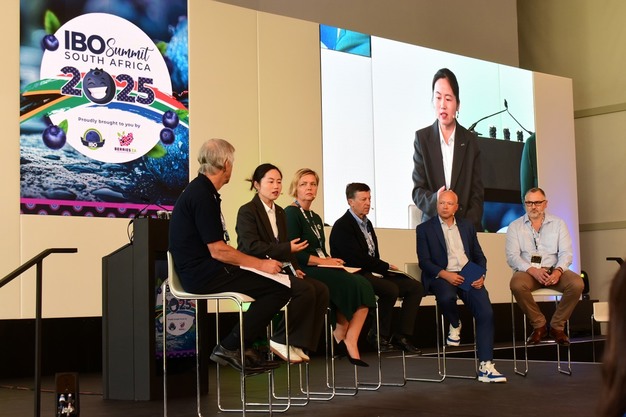 © Carolize Jansen | FreshPlaza.comIn many countries, 20 to 25% of the production cost of blueberries is determined by the cost of picking the fruit: a big headache given the decreasing availability of labour. The presentation on machine harvesting of blueberries attracted much interest, and in the United States, as remarked Marcel Beelen of Finefield, the take-up has been highest on high-chill varieties.
© Carolize Jansen | FreshPlaza.comIn many countries, 20 to 25% of the production cost of blueberries is determined by the cost of picking the fruit: a big headache given the decreasing availability of labour. The presentation on machine harvesting of blueberries attracted much interest, and in the United States, as remarked Marcel Beelen of Finefield, the take-up has been highest on high-chill varieties.
Beelen gave an overview of the different technologies used to avoid bruising as well as to avoid berries falling on the ground after being brushed or shaken off bushes. “Machines are going to replace hand-picking,” he asserted. Roger Horak, founder of United Exports (right), described how in Australia the company “has cracked the code” after almost a decade of testing different harvesters, planting densities, as well as the varieties they’ve been breeding for this purpose.
One characteristic needed by the blueberry varieties to be harvested by machine is that they detach only when very ripe. Horak noted that their Magica variety, a stalwart in other respects, comes apart when picked by a machine. They’ve found that in the first year, the root system is not yet sufficiently anchored to resist mechanical harvesting, and therefore this technology is only for orchards two years and older.
The IBO 2025 summit photo report
In Australia, they have now established 100 hectares to be mechanically harvested, with a similar acreage to be planted in 2026 and 2027. “Machine harvesting is very useful during the peak harvesting period when prices have come down.”
He emphasised that they have no intention to roll out the technology in a country like South Africa, where there is no labour shortage and where, he said, the blueberry industry’s rural employment is paramount.
 © Carolize Jansen | FreshPlaza.comPanel discussion on global production led by Stephen Taylor with Amelie LIu (Joy Wing Mau), Dominika Kozarzewska (Polskie Jagody), Kasey Cronquist (US Highbush Blueberry Council), Andres Armstrong (Chilean Blueberry Council) and George Jesset (Costa)
© Carolize Jansen | FreshPlaza.comPanel discussion on global production led by Stephen Taylor with Amelie LIu (Joy Wing Mau), Dominika Kozarzewska (Polskie Jagody), Kasey Cronquist (US Highbush Blueberry Council), Andres Armstrong (Chilean Blueberry Council) and George Jesset (Costa)
Blueberry value in India lies with pushcart vendors
Sachin Khurana and Gagan Khosla’s feature on India was an insightful counterpoint to the retail session later in the IBO summit programme. The pioneers of blueberry sales are the pushcart vendors who have started stocking blueberries. “The value of blueberries lies with them,” they told delegates. “Wholesale markets are beginning to discern varieties and brands more than retailers. The cold chain in tier 1 cities would surprise you.”
 © Carolize Jansen | FreshPlaza.comSachin Khurana and Gagan Khosla
© Carolize Jansen | FreshPlaza.comSachin Khurana and Gagan Khosla
The IBO 2025 summit photo report
Traditional sales channels still shift 85% of fresh produce in India, with the balance residing with retail and ecommerce (like the country’s famed quick commerce channel). Importers would be wise to spread their product across all channels. Most blueberries imported are sent by air freight.
They emphasised the importance of following labelling norms to the letter and of establishing the right partnerships while keeping in mind that the country’s regions differ markedly.
 © Carolize Jansen | FreshPlaza.com Kevin Hamilton (USHBC), Amelie Liu (Joy Wing Mau), Sabina Wyant (Marks & Spencer), Roger Horak (United Exports), with panel moderator Mike Knowles of Fruitnet
© Carolize Jansen | FreshPlaza.com Kevin Hamilton (USHBC), Amelie Liu (Joy Wing Mau), Sabina Wyant (Marks & Spencer), Roger Horak (United Exports), with panel moderator Mike Knowles of Fruitnet
In the retail panel discussion, Sabina Wyant of Marks & Spencer noted the difference between UK retail and its European counterparts: the latter is heavily dominated by brands, while British retailers employ private labels, noting the varieties and origins of blueberries.
The IBO 2025 summit photo report
The strongest conversion of brands to sales occurs in Asia, noted Roger Horak of United Exports. “Consumers in China are more in tune with what they want,” he said, noting they’d recently seen a 30% premium through the Lán Yǒu Ozblu brand, which was recently launched.
Kevin Hamilton, vice-president of the US Highbush Blueberry Council (USHBC), observed that a repositioning of blueberries in the consumer’s mind – expanding it from the produce aisle into the snack section – is a major focus of their work. With reference to the felicitous pairing of strawberries and Wimbledon, and avocados in the form of guacamole with the US Superbowl, he noted that the soccer World Cup coming to North America would be a perfect marketing opportunity to push blueberries as the healthy snack associated with the event.
